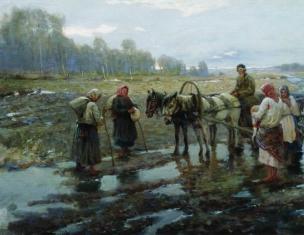The Danube River flows through the territory of 10 European countries, namely: Germany, Austria, Slovakia, Hungary, Croatia, Serbia, Romania, Bulgaria, Moldova and Ukraine. Among the rivers of Europe, it is second only in length and water content.
In addition to the above 10 countries, the Danube drainage basin is in contact with the territories of nine more European countries. In Romania and Ukraine, the Danube River at the point of contact with the Black Sea coast has formed a very extensive delta. Moreover, the Romanian part of this delta is so picturesque that it was included by UNESCO in the list of world-class attractions.
Where is the real source of the Danube?
There is a round rotunda in the German town of Donaueschingen. Someone claims that the Danube River originates at this place.  But many disagree with this statement and point to a place in the Black Forest mountains. According to the second version, the Danube is born by the confluence of 3 streams near Hüfingen.
But many disagree with this statement and point to a place in the Black Forest mountains. According to the second version, the Danube is born by the confluence of 3 streams near Hüfingen.
One of these streams, called Breg, flows from the mentioned town and connects with the stream Brigach, consonant with its name. After another couple of kilometers near Baden-Württemberg they are joined by a third stream, whose name I do not know. 
Merger of Breg and Brigach.
But already 30 km from the confluence of these small rivers, the Danube River disappears! It is not on the surface, it goes into the bowels of the earth in the town of Immendingen (Germany). In fact, the river flows through cracks and craters in the rocks. Only in 1877 were researchers able to establish for certain that the water, after some distance, again came to the surface 12 km to the south. This place was previously called the Aach spring, from here the Danube River continues its movement across the expanses of Europe. By the way, those researchers found a very simple way to determine the flow of the Danube River in 1877 - they dissolved salt in water near Immendingen, and were convinced that after that the water in the Aach spring also became salty.
However, in tourist guides there are also points from which the Breg stream and its “half-brother Brigach” flow, also designated as the beginning greatest river Danube.
Current of the Danube River
The total length of the Danube River is 2960 km. On the shores of this water artery of Europe there are naturally located many major cities, including the capitals of some countries. Along the Danube bed there are:
(function(w, d, n, s, t) ( w[n] = w[n] || ; w[n].push(function() ( Ya.Context.AdvManager.render(( blockId: "R-A -256054-1", renderTo: "yandex_rtb_R-A-256054-1", async: true )); )); t = d.getElementsByTagName("script"); s = d.createElement("script"); s .type = "text/javascript"; s.src = "//an.yandex.ru/system/context.js"; s.async = true; , this.document, "yandexContextAsyncCallbacks");
- Vienna, capital of Austria;
- the city of Belgrade, the capital of Serbia;
- the capital of Hungary, Budapest;
- the capital of Slavakia is the city of Bratislava.
The annual water flow in the river is 6700 m³/s. Slope 0.237 m/km. The Danube is a fairly branched river, with a large number of branches and tributaries. The river receives its main nutrition from the Alps and the Carpathian mountain system. Small mountain streams bring their water to this large artery.
The annual amplitude of water level fluctuations is from 4-5 meters. In winter, the average temperature in the river areas ranges from -1 to -5 degrees Celsius. In summer it rises to +20 °C. Strong cold winds blow almost constantly on the Danube. Air masses reach these areas from the Atlantic and western Asia. The wind speed can reach 30 m/s, which can even change the direction of the river flow to the opposite for some time.
The Danube freezes only at very low temperatures and for a short period of time. This is due to the large river flow.
The Danube River flows into the Black Sea.
Upper, middle and lower reaches
The direction of the river changes several times. The river makes its first bend near Regensourg, the second not far from Passau. 
Danube at Passau
It is believed that the Upper Danube flows to the Hungarian town of Genyu, then the Middle Danube begins. From Passau to Genho the channel goes in one direction. 
Middle Danube
The second part, the Middle Danube, flows without bends, giving way near the Iron Gate to the Lower Danube, which stretches to the very mouth. This is a conditional division of the river bed into 3 parts according to the nature of the flow.
From its source to almost Vienna, the Danube is more of a mountain river. Here the river, flowing down steep slopes, breaks into a narrow valley between the Bohemian massif and the Alps, and its flow exhibits a restless character. In view of this, in the upper reaches of the Danube along the banks, fences, dikes and dams are a frequent occurrence.
In its middle course, the river spreads across the Central Danube Plain. The total width of its branches reaches from 5 to 20 km. The Danube forms small valleys as it passes through mountain ranges. The river narrows, its width does not exceed 150 m, but its depth increases to 20 m. In the Kazan gorge the depth is maximum and is 70 m.
The name Lower Danube Plain speaks for itself. This section starts from the Iron Gate and stretches all the way to the mouth. The width of the floodplain varies between 10-20 km, and branches into numerous channels and branches. In the lower reaches, the river depth decreases significantly to an average of 5 m.
Mouth of the Danube
The delta of the main waterway gave way again. Its area is 4152 km2. The main part of the Danube Delta is located in Romania (3446 km2 or 83% of the area). The remaining 17% belongs to Ukraine. The size of the delta area is constantly changing, which is influenced by siltation of channels and the emergence of others. 
The soil at the mouth of the Danube is marshy, the territory is penetrated by a network of small lakes and small rivers. The main channel of the river is divided into several branches. First it turns into the Kiliya and Tulchinskoe arms. The latter is further transformed into the Sulinskoye and Georgievskoye, which in turn form small secondary deltas. The Kiliya estuary is located on Ukrainian territory; it is considered the fastest flowing. 
The river flows into the Black Sea through 3 main branches:
- Kiliya;
- Georgievsky;
- Suli.
Most of the Danube Delta is occupied by. The entire landscape was placed under UNESCO protection in 1991. On the territory of Ukraine there is a biosphere reserve, which includes a significant part of the Danube delta. The main threat to conservation areas is the Ukrainian and Romanian shipping canals.
The extreme point of the Danube Delta is located in Ukraine on the island of Ankudinov. Oddly enough, the length of the Danube River begins from here, i.e. The Danube is measured from end to beginning, and not vice versa. 
Moreover, if in the first two branches the source indicators range from 1642 to 1868 km, then in the last one it is only 371 km.
Nature
Regular geographical map The Danube does not convey the wealth of flora and fauna that the river possesses.  Populations of birds, rodents, rare reptiles and other animals live along the riverbed. The river is home to 45 species of fish, and in the delta you can even see reed beds. In addition to traditional reeds and algae, on the Middle and Lower Danube all summer you can observe the blooming of water lilies of various types.
Populations of birds, rodents, rare reptiles and other animals live along the riverbed. The river is home to 45 species of fish, and in the delta you can even see reed beds. In addition to traditional reeds and algae, on the Middle and Lower Danube all summer you can observe the blooming of water lilies of various types.
Mention
The first mentions of the Danube known to science are found in the texts of the ancient historian Herodotus, who lived in the 5th century BC. The Father of History, as he was called, wrote that the river Ister (Danube in ancient Greek) originates in the land of the Celts and crosses the center of Europe.
The Istra delta is located in the Evsksinskypont region (Black Sea), and contains seven branches. The current name - Danube - was given, apparently, by the Celts who lived in these territories. It is known that Emperor Trajan ordered the construction of a stone bridge over the Danube in 105 AD.
Well-maintained Danube embankment– an excellent place to explore the sights of more than 10 European countries. The river's length of almost 3,000 km makes it the second longest in Europe and the longest waterway in the EU.
According to scientists, the name appeared in the Proto-Slavic language from Gothic, where it was a transformed Celtic word “Danuvius”. Celtic tribes lived on the banks of the Danube, which was then known as the Ister, in the first half of the 1st millennium BC. e. The famous ancient Greek researcher Herodotus wrote about this in his “History”, dating back to the 5th century. BC e.
The depth in different parts of the Danube River ranges from 2 to 2.8 m, and its source is in the German Black Forest. In the state of Baden-Württemberg, near the town of Donaueschingen, at an altitude of about 700 meters above the plain, the confluence of the Breg and Brigach mountain streams occurs. It is here, near the fortifications of the local fortress, that a well-maintained spring gushes out, considered the source of the famous river.
Source of the river
General information about the Danube
The mouth of the Danube is a delta on the Ukrainian-Romanian border, where its waters mix with the waters of the Black Sea.
The river basin is more than 800 thousand km 2. Along its entire length, sharp turns of the channel are observed: first to the southeast in the German mountain range, and then to the northeast. Near Regensburg is the northernmost point of the river bed, after which it flows again in a south-easterly direction and passes through the Vienna Basin, the Middle Danube Lowland, the Southern Carpathians and the Lower Danube Lowland. The southernmost mark of the channel is located near the Bulgarian town of Svishtov.
Approximately 30 km from its source near Immedingen, this waterway almost completely disappears underground for almost 200 days each year, only seeping through the calcareous rocks.
Depending on the terrain, season and climatic conditions, the level of the navigable Danube River fluctuates between 1-5 m.

Romania and Serbia
Geography of the river
It is not difficult to find on the map where the Danube River is located: it is the adornment of many European countries, as well as a natural boundary for some of them. People can admire its beauty:
- Germany
- Austria
- Slovakia
- Hungary
- Croatia
- Serbia
- Bulgaria
- Romania
- Moldova
- Ukraine
It is also important to know which countries the Danube connects through its fairly extensive basin. Additionally, these include Albania, Montenegro, Bosnia and Herzegovina, the Czech Republic, Italy, Macedonia, Poland, Slovenia, Switzerland, certain regions of which are included in the river delta.

Nature
Major tributaries
To get an idea of the importance of this waterway for the ecosystem of the entire European part of the continent, it is worth studying in more detail which rivers flow directly into the Danube. There are quite a lot of them, both on the right and left sides. The right tributaries are considered (the area of flow is given in brackets):
- Iskar (Bulgaria);
- Iller and Isar (Germany);
- Morava (Serbia);
- Lech (Germany and Austria);
- Sava (Bosnia, Slovenia, Croatia and Serbia);
- Drava (Croatia, Slovenia, Austria, Italy, Hungary);
- Inn (Germany, Austria and Switzerland);
- Raba (Hungary and Austria);
- Enns (Austria).
The left tributaries of the river are (the territory of flow is given in brackets):
- Prut (Romania, Moldova and Ukraine);
- Morava (Czech Republic, Austria, Slovakia);
- Siret (Romania and Ukraine);
- Vág i Hron (Slovakia);
- Tisza (Serbia, Slovakia, Hungary, Ukraine and Romania);
- Ipel (Slovakia and Romania).
The longest tributary of the Danube– Tisza, whose length is slightly more than 960 km. This river flows through the regions of five states.

Tisza River
Excursion along the Danube
River cruises trips along this majestic river are very popular due to the fact that in 7-8 days you have the opportunity to see at least half of Europe. The cost of such a trip on a comfortable ship, depending on the travel conditions, varies from 800 to 2000 euros. The standard route along the Danube includes visiting the following cities:

If a question arises related to the topic “Is the Danube a river in Europe? Yes or no?”, it would not be amiss to pay attention to studying its amazing geographical location, because thanks to its impressive length, the Danube manages to flow through the territories of ten European countries. At the same time, the places near the river amaze with their beauty, and the animals and plants that live both in the river itself and on its banks impress with their diversity, changing in accordance with the type of area.
Where does the Danube flow?
Since the Danube River is the longest in Europe and flows through the territory of many countries, it is popularly called international. Despite the fact that its length is almost 3000 km, this river is still the second longest in the old world after the Volga.
The source of the Danube River originated in Germany, namely in the Black Forest mountains. At the same time, at an altitude of 678 meters above sea level, several mountain streams flow into it at once, the length of each of which exceeds 40 km. Starting its movement in Germany, the Danube passes both through the territory of European countries and along their borders, and ends in Ukraine.
In addition to these countries, the Danube drainage basin is in contact with the territories of nine more European countries. It would also be worth noting the fact that in Romania and Ukraine the Danube River has formed a fairly extensive delta at the point of contact with the Black Sea coast. Moreover, its part, formed in Romania, is such a picturesque and impressive creation of nature that it was included in the UNESCO list of world-class attractions.
History of the Danube River
The first mention of this river was found in works created by the ancient historian Herodotus, who lived in the 5th century BC. It is important that it was thanks to his records that humanity managed to preserve a detailed understanding of the past. He wrote that the Danube River, or, as it was called in ancient Greek, the Ister, originates in the country where the Celts live and crosses the center of Europe. At the same time, the delta of a huge water artery located in the Black Sea region branches into 7 branches of different lengths.

It is believed that the modern name of the river was given by the Celts, but at that time it sounded like Danubium and only later acquired a more simplified version of the pronunciation. That is why when the question arises: “Is the Danube a river in Europe? Yes or no?” You can confidently answer in the affirmative.
Pearl of the Danube
Without a doubt, many countries located in both Central and Eastern Europe would gladly take on the honor of being the capital of the Danube River. However, it is the pearl of Austria, Vienna, with its amazing green hills, that honorably bears the title of the most impressive of the Danube capitals. This is where the Danube reveals its most attractive side. People have managed to preserve a huge number of gardens, lawns and forests, the length of which covers about 20 thousand hectares; you can view them directly from board one of the cruise ships that regularly ply along the Danube.
Danube Valley
Despite the fact that the source of the Danube River originates in the mountains, the most picturesque place In Germany, the Danube Valley is considered to be located in the border city of Passau. It is in this part of Europe that the waters of three large rivers come together. This:
- Ilts.
- Danube.

At the same time, the section of the Danube flowing in the Wachau region was recognized by the world organization UNESCO as a natural heritage of global scale, thanks to which the nature there has remained in its pristine state for many years. Getting here, a person can completely merge with nature, because civilization seems something distant and abstract.
Romanian Danube Delta
The Danube Delta, located in Romania, is a treasure trove of natural attractions. The area where the Danube River is located is the newest and lowest in Romania. The richness of its flora and fauna is impressive in its diversity, remaining as if in a protected niche.
Initially, this territory was the bottom of the bay, and only later it was transformed into an estuary. Historians believe that due to the unique nature, people lived in this area for several thousand years. large number people whose basic needs were more than compensated by what hunting, fishing and reed collection provided. Today, this style of life has been preserved only in villages that are completely isolated by the overflowing canals of a huge water artery - the only way to get to the villages is through them.
Amazing places of the Danube
Based on where the Danube River is located, one can get at least a rough idea of its power, given that the length of the Danube is 2960 km. At the same time, the most mysterious place on the river, without a doubt, remains the area near the city of Immendingen, where the Danube flows under the thickness of the earth. Much of its waters in this area seep through a variety of holes in the limestone rocks that make up the large river valley.

At the same time, somewhat south of the place where the Danube goes underground, the most powerful spring in Germany called the Aach spring emerges from under it. The regime of the Danube River drives water at such a speed that the amount of water flowing from the spring reaches more than 8 tons/sec. Thanks to this power, the Aach Spring was able to serve as the beginning of the Radolfzeller Aach River, which flows all the way to Lake Constance. The most famous river in Germany after the Danube, the Rhine, originates from it.
During a flood, water travels this entire route in less than 24 hours, flowing through huge underground channels. The distance between the place where the Danube River goes underground and the source of the Aach, where it finally comes to the surface, is about 185 meters.
Great River Directions
It is noteworthy that in order to determine the mileage of the river, the extreme point of the arm in the direction of the source is taken as the starting point of reference. Considering its very significant length, it is not surprising that the flow of the Danube River repeatedly changes its direction, maintaining indicators of 1900 m3/s in the middle reaches and 6430 m3/s at the mouth. At the same time, the annual water flow is 123 km 3, due to which the Danube freezes only at very low temperatures and for a short period of time.

Originating in the mountains of Germany, the Danube River spreads to the southeast, after which it turns closer to the north, maintaining this direction until Regensburg, where the northernmost point of the river's flow is located. After this, the Danube turns to the southeast, crossing the Vienna Basin, it levels out on the territory of the Middle Danube Lowland, and after it passes through the chain of the Carpathian mountains and all the way to the Black Sea, it flows through the areas belonging to the Lower Danube Lowland.
Impressive bayous
The Danube River boasts not only its main length, but also the number and length of its branches, which in some cases extend more than 10 km from the main flow of water. On the right side of the Danube, the longest branches are those like Moson and Duneria Veche. Moreover, in the first branch the source reaches 1854 km with a branch of 1794 km, and in the second it is 237 km with a branch of 169 km. Despite these impressive data, the left bank is not only not inferior, but even superior to the right. There are three prominent sleeves here:
- Small Danube.
- Shoroksharsky Danube.
- Borcha.

Moreover, if in the first two branches the source indicators range from 1642 to 1868 km, then in the last one it is only 371 km.
- The largest island located on the Danube River is the island called Žitný in Slovakia.
- The extreme point of the Danube Delta is located in Ukraine on the island of Ankudinov and is the place from where the length begins to be measured. At the same time, it is marked as 0 km.
- According to its features, the Danube River is usually divided into several parts: upper, middle and lower down to the Black Sea.
In addition, if you, having appreciated the beauty of the banks of this huge river, are thinking of purchasing housing in the Danube basin, it is better to avoid coastal settlements, in which the wind under unfavorable weather conditions reaches 20-30 km/h, due to which rapid flooding of coastal areas occurs with unexpectedly overflowing waters.

However, the rich flora and fauna of the Danube have always attracted people, so with certain precautions, you can enjoy unforgettable views of this impressive and beautiful river at any time.
And Romania in the south.
The Danube was and remains primarily a natural border. In former times, it served as the northern border of the Roman Empire. On its banks the Romans built a defensive rampart against barbarian attacks from the north. In 1683, the future of Christian Europe was decided here: the Austrians near Vienna inflicted a final defeat on the troops Ottoman Empire, displacing Muslims from Western Europe.
Since the Danube has always been a navigable river, a variety of tribes and peoples constantly met each other on its banks. They all left behind masterpieces of art and culture - buildings in the Rococo and Baroque, Gothic and Classicist styles are located along the river side by side with Art Nouveau buildings and ancient ruins. Water united people: the Balkans are the largest “melting pot” of Europe; in the Banat between the former Yugoslavia and Romania, Hungarians, Romanians, Serbs, Spaniards, Italians and many other peoples live together amicably. Alas, they do not always get along peacefully with each other. A terrible example of what conflicts between neighbors lead to was the war in the former multinational state of Yugoslavia, the consequences of which are still felt today.
CONNECT, BUT NOT DIVIDE PEOPLES
The Danube is the only river in Europe that flows through so many different countries.
The Danube is formed from the confluence of the Brigach and Breg rivers near the city of Donaueschingen in the Upper Rhine graben. On its 2,860 km long path, the second largest (after the Volga) European river flows through four capitals: Bratislava, Vienna, Budapest and Belgrade. In Romania it flows into the Black Sea, forming a giant delta. The Danube probably served as a transport artery thousands of years ago, and since the beginning of the era of steamships in 1830, its economic importance has constantly increased. In the mid-19th century, neighboring states began to regulate and lock the river. It was necessary to mitigate the effects of periodic floods - for example, in 1830, Vienna was half flooded with water. The Danube has always also been a source drinking water. Disputes about the use of this precious resource periodically arise today. For example, Slovakia is building a system of hydroelectric power plants south of Bratislava to generate electricity. Initially, Hungary participated in this project, but now it categorically refuses to continue construction: the existence of the reservoir reduces the water level to a dangerous level and Budapest is already worried about the stability of supply drinking water. Intensive use of the river has disrupted the ecological balance of vast territories: little remains of the former abundance of fish, floodplain forests are drying up, and many species of animals that traditionally lived on the banks of the Danube are becoming extinct.
USEFUL INFORMATION
■ The oldest stone place across the Danube is in Regensburg (Germany). It was built in 1135-1146.
■ The first nomads settled on the Danube more than 5,000 years ago.
■ Greeks from Miletus settled in the Danube Delta in the 7th century BC.
■ The bank of the Danube is the birthplace of the heroine of German legends, Kriemhild.
ATTRACTIONS
■ In Germany: Hohenzollern-Sigmaringen Castle, Ulm Cathedral, Regensburg.
■ In Austria: Vienna.
■ In Slovakia: Bratislava.
■ In Hungary: Budapest with the parliament building.
■ In Romania: the iron ports and the Danube Delta With its amazing natural landscape.
GENERAL INFORMATION
■ Flows through the following countries:
- Germany Germany
- Austria Austria
- Slovakia Slovakia
- Hungary Hungary
- Croatia Croatia
- Serbia Serbia
- Bulgaria Bulgaria
- Romania Romania
- Moldova Moldova
- Ukraine Ukraine
Encyclopedic YouTube
1 / 3
✪ Every year the Danube adds a square kilometer to Ukraine!
✪ 35 1992 Danube II The Dream of Charlemagne - The Underwater Odyssey of the Cousteau Team
✪ 36 1993 Danube III What the Danube is crying about - The underwater odyssey of the Cousteau team
Subtitles
Etymology
Russian name rivers goes back to Praslav. *Dunaj, which, according to M. Vasmer, was borrowed through Gothic. *Dōnawi from Celtic. Dānuvius. Polish scientist Jan Rozwadovsky suggested that in a word *Dunaj the Slavs originally called the Dnieper (as can be heard in Ukrainian and Belarusian folklore). K. Moshinsky supported this assumption, believing that when part of the Slavs migrated to the vicinity of the Danube, the name of which was originally borrowed as *Dunavъ/*Dunavь, then the name was transferred from the previously known river. Moshinsky was objected to by T. Ler-Splavinsky, who pointed out that the word “Danube” and its derivatives refer to a dozen rivers and streams in the distribution area Slavic languages, Besides, given word functions as an appellative in Polish and Ukrainian dialects. In this regard, Ler-Splavinsky restores for the Proto-Slavic language the common noun *dunajь “big water”, derived from Proto-I.e. *d h ounā . Lehr-Splavinsky’s conclusions were ignored in the work of V. N. Toporov and O. N. Trubachev “Linguistic analysis of hydronyms of the Upper Dnieper region”, which derived the hydronym “Dunaec”, found on Slavic lands from the name of the Danube, for which this work was criticized by Z. Golomb .
Historical information
Early reliable information about the Danube is contained in the writings of the ancient Greek historian Herodotus (5th century BC), who wrote in the second book of Histories that the Ister River (the ancient Greek name for the Danube) begins in the country of the Celts and flows, crossing Europe in the middle (II :33). The Ister River flows into the Euxine Pontus (Black Sea) with seven branches. Modern name given by the Celts, who lived here in the first half of the first millennium BC. In 105 AD, the Roman Emperor Trajan built the first stone bridge across the Danube.
Physical geography
Source
12 km south of the place where the Danube disappears, it shoots out from under the ground incorrect ISO code "Aachtopf"- the most powerful in Germany. The amount of flowing water reaches 8.5 t/sec. The river Radolfzeller Aach originates from here. Radolfzeller Ach), flowing into Lake Constance, from where the Rhine flows.
Direction
On its way, the Danube changes direction several times. First, it flows through the mountainous region of Germany to the southeast, and then at around 2747 km (the kilometer of the river is measured from the extreme point of the arm in the direction of the source) it changes direction to the northeast. This direction continues until the city of Regensburg (2379 km), where the northernmost point of the river flow is located (49 ° 03 "N). Near Regensburg, the Danube turns southeast, then crosses the Vienna Basin, and then flows for more than 600 km along the Middle Danube Lowland. Having laid a channel through the mountain ranges of the Southern Carpathians along the Iron Gate gorge, it flows along the Lower Danube Lowland all the way to the Black Sea (more than 900 km).
The southernmost point of the river is located near the city of Svishtov (Bulgaria) - 43°38"N.
Delta
In the lower reaches of the Danube, branching out, it creates a large swampy delta, cut through by a dense network of branches and lakes, 75 km long from west to east and 65 km wide from north to south. The top of the delta is located near Cape Izmailsky Chatal, 80 km from the arm, where the main channel of the Danube first splits into the Kiliya and Tulchin arms. 17 kilometers downstream, Tulchinskoye is divided into the Georgievskoye branch and the Sulinskoye branch, which flow into the Black Sea separately. The Kiliya branch within the borders of the territory of Ukraine creates the so-called Kiliya delta, which is the most fleeting part of the Danube delta. Most of the Danube delta is covered with floodplains - this is the second largest area of this landscape in Europe (second only to the floodplains in the Volga delta). The Danube Biosphere Reserve is located in the Danube Delta.
Sleeves
The Danube has numerous branches, which sometimes diverge significantly (10 kilometers or more) from the main flow. The longest on the right bank are the branches of the Moson or Gyor Danube (source - 1854 km, branch - 1794 km) and Duneria-Veke (237 and 169 km); on the left bank - the Small Danube (source - 1868 km, flows into the Vag), Shoroksharsky Danube (1642 and 1586 km), Borcha (371 and 248 km).
Tributaries
The Danube basin has an asymmetrical shape. Its right bank part is smaller in size (44% of the catchment area). But on the right bank, the tributaries of the Danube form the hydrographic grid of the basin. The tributaries are distributed unevenly: most of them are located in the foothills of the Alps and Carpathians; there are almost none of them in the territory of the Hungarian (Middle Danube) lowland.
The tributaries of the Danube, which originate in the mountains, have a mountainous character in the upper reaches. Entering the plain, they acquire the typical features of lowland rivers and are navigable over a long distance.
Tributaries that have a significant impact on the water regime of the Danube are listed in the table.
| Name | Confluence with the Danube (shore) |
Distance (from the mouth) km |
Countries through which it flows (from source) |
Length km |
|---|---|---|---|---|
| Iller | right | ~ | Germany Germany | 163 |
| Lech | right | ~ | Austria Austria, Germany Germany | 265 |
| Izar | right | 2281,7 | Germany Germany | 283 |
| Inn | right | 2225,2 | Switzerland Switzerland, Austria Austria, Germany Germany | 525 |
| Ens | right | 2111,8 | Austria Austria | 255 |
| Morava | left | 1880,3 | Czech Republic Czech Republic, Slovakia Slovakia, Austria Austria | 380 |
| Slave | right | 1794,0 | Austria Austria, Hungary Hungary | 398 |
| Vag | left | 1765,8 | Slovakia Slovakia | 402 |
| Gron | left | 1716,0 | Slovakia Slovakia | 289 |
| Ipel | left | 1708,2 | Slovakia Slovakia, Hungary Hungary | 233 |
| Drava | right | 1382,5 | Italy Italy, Austria Austria, Slovenia Slovenia, Hungary Hungary, Croatia Croatia | 720 |
| Tisa | left | 1214,5 | Romania Romania, Ukraine Ukraine, Slovakia Slovakia, Hungary Hungary, Serbia Serbia | 966 |
| Sava | right | 1170,0 | Slovenia Slovenia, Croatia Croatia, Bosnia and Herzegovina Bosnia and Herzegovina , Serbia Serbia | 940 |
| Morava | right | 1104,5 | Serbia Serbia | 563 |
| Iskar | right | 637,3 | Bulgaria Bulgaria | 368 |
| Siret | left | 155,2 | Ukraine Ukraine, Romania Romania | 726 |
| Rod | left | 134,0 | Ukraine Ukraine, Moldova Moldova, Romania Romania | 950 |
Islands
Other characteristics
At a straight line distance between the source (Donaueschingen) and the extreme point of the delta (mark “0 km” in the Ukrainian part of the delta below the city of Vilkovo on the island of Ankudinov) of 1642 km, the river tortuosity coefficient is 1.71. The average decline of the Danube is 24.4 cm per 1 km.
Parts of the Danube (Danube)
Based on a set of physical and geographical characteristics, the Danube is divided into the following three parts:
- Upper (992 km) - from the source to the village of Genyu;
- Middle (860 km) - from Genho to the city of Drobeta-Turnu Severin;
- Nizhny (931 km) - from the city of Turnu-Severin to the confluence with the Black Sea.
Climate
Mode
The annual amplitude of water level fluctuations ranges from 4.5-5.5 m (near Reni) to 6-8 m (near Budapest). Ordinary annual water flows at the top, currents are 420 m 3 /s, in the middle reaches - 1900 m 3 /s, at the mouth - 6430 m 3 /s. The maximum water flow in the lower reaches is 20 thousand m 3 /s, the minimum is 1800 m 3 /s. The annual flow is about 123 km 3 per year. The Danube freezes only in cold winters for 1.5-2 months.
Temperatures
The temperature regime in the Danube basin is determined mainly by the nature of the circulation of air masses and the features of the terrain. Air temperature varies over a wide range. In winter, the average temperature of the coldest month - January - ranges from −5 to −1 °C. In summer, the average temperature of the warmest month - July - in the upper part of the basin is from +16 to +18 °C, in the central part of the basin - from +17 to +22 °C, in the lower part - from +22 to +26 °C.
Winds
The Danube basin is influenced by air masses penetrating from the Atlantic, Eastern Europe and western Asia.
In the Upper Danube region, the prevailing winds in the cold season are winds from the west and north-west. On the Middle Danube the eastern and south-eastern winds predominate, on the Lower Danube - northern and north-eastern ones.








